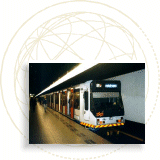Paris
- RATP
Crime prevention measures
 To cope with the contemporary problems of crime, misdemeanours,
and nuisances, RATP has established a policy consisting of station
renovation, reduction of pollution, social and humanitarian action,
formal control, and crime prevention technologies. During the
past two years, all metro stations have been renovated and brightened
up. Pollution is reduced by the hiring of outside cleaning companies
whose performance is constantly being evaluated by imposing satisfaction
indicators. The battle against graffiti is given special attention.
All trains and vulnerable station objects are covered in graffiti-resistant
coating and 18,000 tags are removed each year (on metro and RER
lines). A Social and Humanitarian Action Unit was established
to reduce the need for homeless people to loiter and/or sleep
in the metro. With the assistance of charitable associations,
shelter is provided, a minimum of health care is given, and hot
meals are distributed outside the underground precincts. Formal
control is provided by security agents (the GPSR) and Railway
Police. The agents are divided between 5 decentralised districts
and 6 base camps. The agents' actions are managed by one centralised
police and GPSR station; the PC 2000. This centre monitors the
audio and video monitorings of the 600 CCTV cameras, 120 radio-located
vehicles, 200 information & emergency terminals (call boxes),
and the security radio network.
To cope with the contemporary problems of crime, misdemeanours,
and nuisances, RATP has established a policy consisting of station
renovation, reduction of pollution, social and humanitarian action,
formal control, and crime prevention technologies. During the
past two years, all metro stations have been renovated and brightened
up. Pollution is reduced by the hiring of outside cleaning companies
whose performance is constantly being evaluated by imposing satisfaction
indicators. The battle against graffiti is given special attention.
All trains and vulnerable station objects are covered in graffiti-resistant
coating and 18,000 tags are removed each year (on metro and RER
lines). A Social and Humanitarian Action Unit was established
to reduce the need for homeless people to loiter and/or sleep
in the metro. With the assistance of charitable associations,
shelter is provided, a minimum of health care is given, and hot
meals are distributed outside the underground precincts. Formal
control is provided by security agents (the GPSR) and Railway
Police. The agents are divided between 5 decentralised districts
and 6 base camps. The agents' actions are managed by one centralised
police and GPSR station; the PC 2000. This centre monitors the
audio and video monitorings of the 600 CCTV cameras, 120 radio-located
vehicles, 200 information & emergency terminals (call boxes),
and the security radio network.
|
Source: López, M.J.J., Crime Prevention
Guidelines for the Construction & Management of Metro Systems,
Den Haag: RCM-advies 1996, pg. 19-20.
 Order
this book Order
this book
|

 To cope with the contemporary problems of crime, misdemeanours,
and nuisances, RATP has established a policy consisting of station
renovation, reduction of pollution, social and humanitarian action,
formal control, and crime prevention technologies. During the
past two years, all metro stations have been renovated and brightened
up. Pollution is reduced by the hiring of outside cleaning companies
whose performance is constantly being evaluated by imposing satisfaction
indicators. The battle against graffiti is given special attention.
All trains and vulnerable station objects are covered in graffiti-resistant
coating and 18,000 tags are removed each year (on metro and RER
lines). A Social and Humanitarian Action Unit was established
to reduce the need for homeless people to loiter and/or sleep
in the metro. With the assistance of charitable associations,
shelter is provided, a minimum of health care is given, and hot
meals are distributed outside the underground precincts. Formal
control is provided by security agents (the GPSR) and Railway
Police. The agents are divided between 5 decentralised districts
and 6 base camps. The agents' actions are managed by one centralised
police and GPSR station; the PC 2000. This centre monitors the
audio and video monitorings of the 600 CCTV cameras, 120 radio-located
vehicles, 200 information & emergency terminals (call boxes),
and the security radio network.
To cope with the contemporary problems of crime, misdemeanours,
and nuisances, RATP has established a policy consisting of station
renovation, reduction of pollution, social and humanitarian action,
formal control, and crime prevention technologies. During the
past two years, all metro stations have been renovated and brightened
up. Pollution is reduced by the hiring of outside cleaning companies
whose performance is constantly being evaluated by imposing satisfaction
indicators. The battle against graffiti is given special attention.
All trains and vulnerable station objects are covered in graffiti-resistant
coating and 18,000 tags are removed each year (on metro and RER
lines). A Social and Humanitarian Action Unit was established
to reduce the need for homeless people to loiter and/or sleep
in the metro. With the assistance of charitable associations,
shelter is provided, a minimum of health care is given, and hot
meals are distributed outside the underground precincts. Formal
control is provided by security agents (the GPSR) and Railway
Police. The agents are divided between 5 decentralised districts
and 6 base camps. The agents' actions are managed by one centralised
police and GPSR station; the PC 2000. This centre monitors the
audio and video monitorings of the 600 CCTV cameras, 120 radio-located
vehicles, 200 information & emergency terminals (call boxes),
and the security radio network. Order
this book
Order
this book